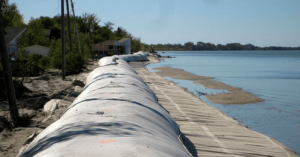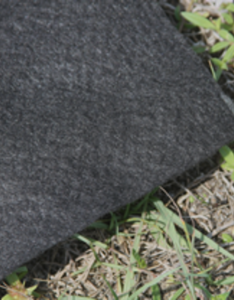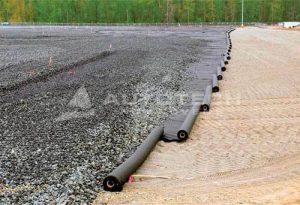What is a Geocomposites Drainage Layer?
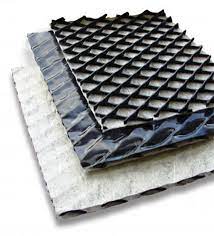
Geocomposites drainage systems are structured to complement or replace sand, stone, and gravel to act as drainage, filtration, separation, and barrier protection. To assure their workability and long-term performance, the right geocomposites material should be attentively selected. The required parameters of the drainage solution can be formulated through performance testing according to the drainage system design configuration and site-specific conditions.
Important performance properties that should be assessed at the time of the design and selection of drainage geocomposites include the following:
Long-term permeability or allowable flow rate under field conditions – this will ascertain the in-plane flow under site-specific backfill material and boundary conditions, structural strength, and durability, propensity for biological congesting, and chemical congesting.
Long-term void enduring structures are crucial for performance transmissivity due to the environmental effects on the in-place geocomposites and overload stress.
The filtration aspects of the geotextile and its compatibility according to the soil particle at the field
Inner shear strength and interface friction with adjoining soil and/or “geo” layers.
Flexible or collapsible
Drainage geonets may show high resistance to compression in the short term and might be prone to a sudden collapse in case the loads are maintained for a long period. It is therefore essential to evaluate, at the design level, in case the geonets core behaves as flexible or collapsible for the specific field conditions, i.e., utilized load, slope gradient, and design life.
The drainage volume of geocomposites is directly equivalent to the thickness of the geonets core. The reference value of the flow rate should therefore be determined just when the utilized loads and the geocomposites have reached an equilibrium and without more reduction of thickness and drainage volume. While flexible drainage materials achieve equilibrium in just a few hours, it is tougher for collapsible drainage materials to achieve equilibrium in compression.
How the reference value of the flow rate is determined will be based upon whether the geocomposites is expected to behave as flexible or collapsible.
Flow-rate factors
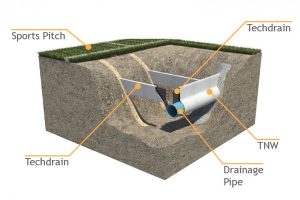
The overloading pressure to which drainage geocomposites may be subjected differs greatly from one application to another. This can be from 10 kPa under the coating of topsoil in a roof garden, up to 500 kPa as a leachate collection coating at the bottom of a landfill cell, or the base of a very huge embankment and mining stack leach pad (> 25m). Higher loads are possible but not frequent.
The available flow rate of a particular geocomposites will depend on the following factors:
- Kind and characteristics of the geonets drainage core
- Kind and characteristics of the filter geotextile, and their band to the drainage core
- Characteristics of the materials in link with the two surfaces of the geocomposites
- Applied force
- Load duration (typically equal to the design life)
- The hydromechanical gradient of the geocomposites
A general procedure for controlling the allowable flow rate of drainage geocomposites in most applications is applying a set of reduction aspects that take into account all the ambiguity and phenomena related to material properties, weather, and other aspects that might decrease the in-plane flow volume of the geocomposites over the entire design life, but not citing to the short-term flow rate measured in the index tests.
The reduction aspects should be set to the specific conditions of every project, factoring in imperfection and/or research on the same conditions of use. Project-specific tests may as well as be used to state the proper reduction aspects for each project condition.
- Reduction aspect for creep: This is a long period (usually 10,000 hours) flexible load test targeted at the stability and/or contortion of the drainage core without sheltering geotextile. Stress orientation can be crosswise or at an angle to the test specimen, based on the site-specific conditions.
- Chemical and/or biological congesting: This is a site-specific issue of long-term reduction aspect that takes into consideration congesting within the core space. It is significantly impractical to simulate in the laboratory and the range of congesting reduction aspects is provided as a guide in GRI-GC8.
- Chemical persistence/durability: This process results in a “go/no-go” decision as to potential chemical reactions between the permeating liquid and the polymers that build up the drainage core and geotextile. This is a product-particular verification test for both drainage core and geotextile covering.
What does this intend for the user?
- To select the right geocomposites for particular applications, the quoted geosynthetics drainage design issues must be taken into consideration:
- Applied burden – the overload pressure imposed on top of the drainage material
- Hydromechanical gradient – the slope angle
- Boundary conditions – the interface and composition of the overlying and underlying materials while the testing of the drainage geocomposites should mimic actual field conditions
- Seat time – the structured lifespan (GRI-GC8 needs a seating time of a minimum of 100 hours for the laboratory transmissivity testing)
Gas or liquid being transmitted via the drainage structure
Understanding all these parameters will help engineers to figure out the long-term performance of the drainage geocomposites and, most vital, assures the success of the project.
If you like this blog you should also read about The Types of Geocomposites.

